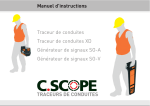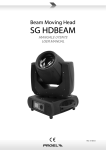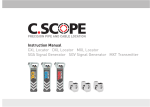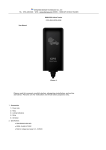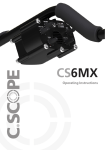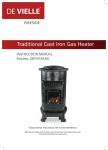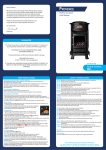Download C-SCOPE XD Instruction manual
Transcript
Instruction Manual Cable Avoidance Tool Cable Avoidance Tool XD Signal Generator SG-A Signal Generator SG-V CABLE AVOIDANCE TOOLS WARNINGS The C.Scope Cable Avoidance Tools locate services radiating a detectable field. There may be some services that do not radiate and cannot be located. ALWAYS EXCAVATE WITH CARE Do not use the equipment outside of the temperature range -10˚C to +50˚C as the batteries may cease to function adequately. Geographical conditions such as hills and mountains can effectively screen radio signals and prevent a detectable ground current. The C.Scope Cable Avoidance Tool alone will not always locate every conductor so always use a Signal Generator. The C.Scope Signal Generator leads must not be connected directly to a live service. System performance may be impaired by unusually strong electromagnetic fields. Beware of multiple services. The C.Scope Cable Avoidance Tool will not always indicate close services, either side by side or one above the other. Do not use the equipment in areas where hazardous gases may be present. Check for underground services before using the earth stake. Copyright © 2004 C.Scope International Ltd. All Rights Reserved. C.Scope International Ltd make every effort to ensure that the information we provide about our products and their use is correct. We do not accept responsibility for injury, damage, or consequential loss arising from the use of our products. Local, national and international requirements and regulations must take preference. Contents Warnings Inside Front Cover Features Using the Signal Generator 12 Batteries 13 Cable Avoidance Tool (and XD Model) 1 Direct connection 14 Signal Generator (SG-A and SG-V Models) 2 Street lighting 16 Locator Operating Modes Signal Clamp/ Injector 17 Power 4 Searching 18 Radio 5 Tracing 19 Generator 6 Using the Locator Induction 20 Searching 21 Batteries 7 Multiple Services 23 Holding the Locator 8 Inductive Sweep 24 Searching 9 Non-Metallic Pipe Tracing 25 Pinpointing 10 Sonde 26 Tracing 11 Plastic Pipe Tracer 28 Depth Measurement Sonde/ Plastic Pipe Tracer 30 32 Function checks 33 Maintenance 37 Specifications Cable Avoidance Tool Signal Generator Support Services 38 39 40 The C.Scope Cable Avoidance Tool (And XD Model) Digital display Digital display Depth measurement button (XD model only) Mode selected: Generator (showing frequency) Power Radio Detachable loud speaker On/ Off switch Sensitivity control 3 position mode switch Depth display (XD Model only) 1 Battery compartment Signal strength bar display Replaceable wear foot Battery condition indicator The C.Scope Signal Generator (SG-A and SG-V Models) Digital display (SG-V only) On/Off switch Battery condition indicator Mute/loud setting Loud/Mute switch Power output level indicator Pulsed/Continuous output switch Induced or connected mode indicator High power switch Signal strength bar display Low power switch Batteries Direct connection socket Auxiliary earth lead socket Accessory tray 2 The C.Scope Signal Generator (SG-A and SG-V Models) Accessory tray Accessory tray holding clips Earth stake Direct connection leads Crocodile clips Auxiliary 10m earth lead Connection magnet 3 Locator Operating Modes: Power Mode In Power Mode the locator detects power signals. These power signals are present on all current carrying electricity cables although not all are detectable. These power signals may also flow along other buried conductors such as metal gas and water pipes. Limitations of Power Mode Not all electricity cables can be found using the Power mode. Here are the most important examples of electricity cables that may not be detectable in the Power mode: ● ● ● ● ● Street lighting cables. When the lights are off, no current flows and so no power signal is created. Supplies to buildings or plant using very little or no electricity will not have a detectable power signal. Pot-ended or capped cables. These will never have any current flowing through them but are possibly still live. Disused or abandoned cables. A few high voltage electricity cables. These can be “well balanced”, electrically and therefore radiate little or no Power signal. ● Direct current cables (such as those found on railway systems). These do not create their own Power signals. ● Cables more than 3 metres deep. WARNING Locators can only detect services radiating a detectable electromagnetic signal. There may be some services that do not radiate these signals and cannot be located. WARNING Absence of Power signal does not mean the service is not live. NOTE Generally these services should be detectable using the Radio or Generator modes. 4 Locator Operating Modes: Radio Mode In Radio mode, the locator detects signals from radio transmitters. These signals flow through the ground and will tend to follow the line of least resistance such as a buried metallic service. When this happens the service can often be detected by using the locator in Radio mode. Limitations of Radio Mode ● Not all services will be detectable in Radio mode. ● A strong Radio signal present on one service may be masking a weaker Radio signal present on an adjacent service. ● It is not normally possible to determine WHAT the service is in Radio mode, only it’s position. ● Radio signals do not favour one utility over another. ● The depth of the buried service CANNOT be judged by the strength of the radio signal alone. ● Normally it is only possible to detect Radio signals present on services up to 2 metres deep. ● A short service may not have enough signal to be detected. WARNING Locators can only detect services radiating a detectable electromagnetic signal. There may be some services that do not radiate these signals and cannot be located. NOTE Most buried metallic services not found in Radio mode should be detectable by using Generator mode with a Signal Generator. 5 Locator Operating Modes: Generator Mode In Generator mode the locator detects conductors radiating a signal applied by the Signal Generator. The Signal Generator provides a way of sending a known signal along buried metallic services which can then be detected using the locator. Direct Connection By detecting this signal it is possible to locate, trace and identify the pipes or cables that may be carrying it. There are TWO basic methods by which the Signal Generator signal can be applied to buried services: Direct Connection - The Signal Generator is attached directly to the service using either the Direct Connection Leads or one of the accessories available for use with the Signal Generator such as the Signal Clamp of Signal Injector. Induction Induction - The Signal Generator can induce a signal onto a buried metallic service remotely from the surface without the need to physically connect to that service. Limitations of Generator Mode are covered in Using the ‘Signal Generator’ section of this manual. WARNING Locators can only detect services radiating a detectable electromagnetic signal. There may be some services that do not radiate these signals and cannot be located. 6 Using the Locator: Batteries Locator Battery Check Switch the locator on by pulling up on the On/Off trigger positioned on the underside of the handle. The locator should emit a clear audible battery check tone for one second and the display should come on. Battery levels Check the battery level indicator in the bottom left hand corner of the display. If there is only one segment or no segments of the indicator filled in then the batteries will need to be renewed before locating work can begin. Changing Locator Batteries Push the two clips back to release the battery compartment door. Remove ALL EIGHT used batteries and replace with new ones. Be careful to insert the new batteries the correct way round in the holder. Replace the holder in the battery compartment making sure that the two terminals on the holder make contact with the two terminals within the battery compartment. Close the battery compartment door securely. NOTE Only use alkaline AA (LR6) size batteries. Dispose of the used batteries safely in accordance with local regulations. WARNING Do not change batteries in confined spaces where gas may be present. 7 Using the Locator: Holding the Locator When in use the locator should always be held upright. NEVER swing the locator such that it moves away from the vertical. Your middle or little finger should be used to squeeze, and hold on, the On/Off trigger. Your index finger will then be free to adjust the sensitivity control. 8 Using the Locator: Searching There are three stages to the locating process; searching, pinpointing and tracing 1. Turn the function switch to the appropriate mode 2. Hold in the On/Off trigger. The locator should emit the audible battery test tone and the digital display should come on. Check the battery level indicator to confirm the batteries are usable. 3. Rotate the Sensitivity control clockwise to its maximum setting as indicated by the arrow on the control. 4. Carry out the search using a grid pattern as shown in the diagram. Walk slowly and keep the locator upright at all times and stationary by your side. 5. As you approach the area in which there is a signal the locator will emit an audible response and show a visual response on the bar display. 6. Keep walking until the audible and visual responses disappear. NOTE This search technique applies only to the Power and Radio modes. See ‘Using the Signal Generator’ for the correct search pattern when using Generator mode. NOTE Sometimes the locator will give an audible response and strong (full scale) visual response across the whole of the search area. In this case turn the sensitivity down slightly and repeat the search using the same grid pattern. 9 Using the Locator: Pinpointing Having found the presence of a signal the next stop is to pinpoint the source. The closer the locator is to the signal source the stronger the response. To Pinpoint a Signal 1. Keeping the locator vertical, walk through the area of the signal response. If the visual response goes off the scale then stop, reduce the sensitivity of the locator slightly before continuing. 2. The width of the signal response will begin to shrink as the sensitivity is reduced. Once the sensitivity is reduced enough then a clear peak response will be seen on the bar display as the locator traverses the service. The locator is positioned directly above the buried service when the bar display is at its highest (peak) reading. 3. Carefully rotate the locator over the peak reading until the visual response falls to a minimum level. The locator will now be roughly IN LINE with the direction of the buried service. 4. Mark the position of the buried service. NOTE The amount of sensitivity adjustment needed to pinpoint a service can vary depending on the mode being used, the signal strength and the service depth. 10 Using the Locator: Tracing Having pinpointed a service it should now be possible to trace it’s route. 1. Carefully follow the direction of the signal holding the locator at right angles to the line of the signal. It is necessary to constantly ‘slice’ the locator from side to side in order to be sure of still being over the peak signal response. 2. Stop and mark the position of the signal at regular intervals. As more marks are recorded the precise direction of the service will become more apparent. NOTE It may be necessary to readjust the sensitivity to maintain the optimum response. NOTE After tracing return to the original search grid to search for further buried services. WARNING Never rush the tracing process. Small and unexpected changes in the service’s route will be missed if care is not taken to follow the signal’s path every step of the way. Lost Signals This can be because of a curve, or bend in the route, change in depth of the service, a T connection or the end of the service. Finding Lost Signals 1. Locate in a circle at least 1metre around the point where the signal was lost. This should locate the service if it has simply changed direction sharply or ‘T’d’ into another service. 2. If you find nothing then increase the sensitivity and repeat the circle. This should find the service if it has continued but at a greater depth. 11 Using the Signal Generator Using the locator in Power and Radio modes will only allow you to locate and mark the position of buried services that are producing a Power signal or re-radiating a Radio signal. Use of the Signal Generator should enable most, if not all, of the remaining buried metallic services to be detected and traced. This section explains the various ways in which the Signal Generator can be used. It also shows how to use those accessories that allow the Signal Generator to be directly connected to specific services. Direct Connection - Physically connecting the Signal Generator to a service is the most effective way to transfer the signal onto that service and the best way to trace the route of that service. Signal Clamp - The Signal Clamp is an accessory that allows the Signal Generator signal to be applied to a specific cable without having to make electrical contact with that cable. Although the Signal Clamp is not physically fixed to the cable we still consider it as a Connection method because it is using the Signal Generator in Connection mode. Signal Injector - The Signal Injector is an accessory that allows the Signal Generator signal to be safely applied to an electrical system via a conventional 3-pin power socket. This signal will then be detectable on the buried supply cable outside the building. Induction - Induction is a method of applying a signal to a service to which there is no direct access. NOTE The locator should always be handled and operated according to the instructions shown in the ‘Using the Locator’ section unless specifically shown otherwise in this section. 12 Using the Signal Generator: Batteries Battery Check Switch the Signal Generator on by pressing the On/Off switch. The Signal Generator should emit a loud continuous tone. If the batteries need replacing an interrupted tone will be heard. During use, the Signal Generator will also warn the locator user of low battery status by altering its normal continuous or pulsed signal output to a distinct interrupted signal output. SGV only SGV only Check the battery level indicator in the bottom left hand corner of the display. If there is only one segment or no segments of the indicator filled in then the batteries will need to be renewed before locating work can begin. Changing the Batteries ● Remove the accessory tray. ● Undo the two round knurled retaining screws situated on the underside of the Signal Generator holding the battery cover. ● Remove ALL FOUR used batteries and replace with new ones. ● Be careful to insert the new batteries the correct way round in the compartment as indicated on the case. ● Replace the battery cover being careful to not over tighten the retaining screws. ● Replace the accessory tray. NOTE Dispose of the used batteries safely in accordance with local regulations. NOTE Only use alkaline D (LR20) size batteries WARNING Do not change batteries in confined spaces where gas may be present. 13 Using the Signal Generator: Direct Connection WARNING Never connect directly to electrical services. WARNING You may need to seek permission from the service owners before connecting on to some buried services. The direct connection leads and earth stake that are supplied with the Signal Generator are used to apply a signal to any metal pipe at a suitable access point such as a valve, hydrant point, stop cock or exposed pipe length. 1. Plug the direct connection leads into the Signal Generator connection socket. 1. 2. 2. Attach the red lead to the pipe at your point of access using the crocodile clip. Ensure that you have a secure and clean grip on the pipe with the crocodile clip. 3. Turn the Signal Generator on. NOTE The type of metal that the pipe is constructed from or it’s use will have little effect on its traceability. NOTE If it is not possible to get the crocodile clip to grip the pipe then use the magnet on the back of the clip. 14 Using the Signal Generator: Direct Connection 4. Place the Earth Stake in the ground (having first searched the area for buried cables with the locator). The ideal position for the Earth Stake is at right angles to the assumed line of the pipe and the full length of the direct connection leads away from the pipe access point. 5. Connect the black earth lead to the Earth Stake (or the alternative earth point). If your earth point is too far away from the pipe access point for the black earth lead to reach then use the yellow 10 metre auxiliary earth lead instead. 6. As the earth lead is connected to the earth stake the audible signal from the Signal Generator should change in tone. The greater the change in tone, then the better the signal will be on the metal pipe. SG-V only If there is no change of tone at all it may be that some dirt, rust or paint on the pipe is preventing the direct connection lead from making a good contact with the pipe. Alternatively it may be that your earth point is at fault. Change the position of the earth stake or use an alternative earth point. The SG-V Signal Generator will also give a visual representation of the quality of the connection in addition to the audible tone change. The greater the response on the display then the better the signal will be on the pipe. NOTE If it is not possible to use the Earth Stake use a nearby metal fence post, manhole cover or gully cover. DO NOT use something that may have another metallic service attached to it, such as a metal street lighting column. NOTE If the Signal Generator tone does not change then there is no signal being transferred onto the service. 15 Using the Signal Generator: Direct Connection Direct Connection to a Street Lighting Column The position and route of street lighting or car park lighting cables can be determined by using a Signal Generator and the pipe connection method. Follow the same rules as for connecting the Signal Generator to a metal pipe except attach the red direct connection lead to the OUTSIDE of the lamp column. WARNING NEVER open the lamp column door to gain access to the cables, this is dangerous and not necessary. NOTE Make sure that the direct connection crocodile clip is not insulated from the metal of the column by paint. NOTE If the column is concrete attach the crocodile clip to the metal surround of the access door. 16 Using the Signal Generator: Signal Clamp/ Injector Signal Clamp 1. Plug the Signal Clamp into the connection socket on the Signal Generator. 2. Turn the Signal Generator on. 3. Check that the jaws of the clamp are clean. Place the Signal Clamp AROUND the cable making sure that the jaws are able to fully close. The audible signal from the Signal Generator should change in tone indicating that the clamp jaws have closed correctly. WARNING NEVER attempt to place the Signal Clamp around electricity cables that are deliberately suspended out of reach. They may be unsheathed or unprotected cables. NOTE The Signal Clamp cannot apply a signal to a cable that is not earthed at both ends such as abandoned cables that have been cut off where they appear above ground or small cables supplying unearthed equipment. Signal Injector 1. Plug the Signal Injector into the connection socket on the Signal Generator and an electric outlet. 2. Turn the Signal Generator on. 3. Turn the socket on. The audible tone from the Signal Generator will drop in pitch to indicate a successful connection. NOTE On two wire Protective Multiple Earth (PME) systems it may be necessary to also provide an external earth using the yellow 10 metre Auxiliary Earth Lead and Earth Stake. NOTE Always check with the owners that it is acceptable to interrupt the supply before connecting the Signal Injector. NOTE Using the Signal Injector may cause the system protection to trip. WARNING DO NOT use the Signal Injector on systems with voltages in excess of 240 volts AC. Domestic systems will normally be below this voltage. 17 Signal Generator: Searching for the Direct Connected Signal The Search pattern used to find the Signal Generator signal when applied by a direct connection method (Direct Connection Leads, Signal Clamp or Signal Injector) is different to the normal search pattern used on Power or Radio Modes. 1. Move a few paces away from where the Signal Generator has been connected to the service. Turn the mode switch to Generator mode. Hold the locator so that the side of the locator is facing towards the Signal Generator. 2. Adjust the Sensitivity so that the locator is just showing a visual response and emitting an audible response. 3. If possible walk in a COMPLETE circle around the connection point trying to keep the same distance from this point at all times. When a signal is detected, ‘pinpoint’ that signal as shown in the ‘Using the Locator’ section. 4. Having pinpointed the first signal, do NOT readjust the Sensitivity control but continue with the circle to see if any other signals are detected. If more signals are detected compare the strength of each signal by observing the bar display. The strongest signal will usually be coming from the service that the Signal Generator is connected to. 18 Signal Generator: Tracing the Direct Connected Signal The tracing technique used to follow the Signal Generator signal when applied by a direct connection method (Direct Connection Leads, Signal Clamp or Signal Injector) is almost exactly the same as the normal tracing technique used on Power or Radio Modes but with the following differences: NOTE It is not possible to search for the signal above any leads connecting the Signal Generator to the service or above the Earth Lead connected to the Earth Stake. The signal that the locator is detecting will get weaker the further away from the Signal Generator that you go. It will be necessary to regularly adjust (increase) the locator sensitivity to compensate for this. 19 Signal Generator: Induction This is the standard method for inducing signals onto buried metallic services. It produces a strong signal directly below the Signal Generator but the signal strength drops off quite quickly either side of the Signal Generator. 1. Check that there are no accessories plugged into the Connection Socket. The Signal Generator switches automatically to Induction Mode when the socket is clear. 2. Place the Signal Generator UPRIGHT on the ground where you suspect there may be some services buried. Make sure the Signal Generator is IN LINE with the expected route of these services. 3. Turn the Signal Generator on and check that the batteries are OK. 4. The signal will be radiated into the ground immediately below and for approximately 3 metres either side of the Signal Generator. NOTE The closer the Signal Generator is to the position of the buried service then the stronger the signal will be on that service. 20 Signal Generator: Searching for an Induced Signal The search pattern used to find the Signal Generator signal when applied by Induction is slightly different to the search pattern used on the Power or Radio Modes or with the Signal Generator on the Direct Connection mode. 1. Move AT LEAST 10 metres away from the Signal Generator position with your locator. This is to avoid the locator picking up the airborne signal rather than the signal induced onto the buried service. 2. Stand so that you are roughly in line with the end of the Signal Generator and hold the locator so that the side of the locator is facing towards the end of the Signal Generator. 3. Adjust the Sensitivity so that the locator is just showing a visual response and emitting an audible response. NOTE A Signal Generator will transmit a significant amount of signal into the air as well as into the ground. NOTE Make sure you keep the locator upright at all times to avoid the risk of picking up the airborne signal. 21 Signal Generator: Searching for an Induced Signal 4. Walk in a straight line across the end line of the Signal Generator. When a signal is detected ‘pinpoint’ that signal as shown in the ‘Using the Locator’ section. If no signal is found move the Signal Generator 5 metres and try again. Continue this procedure moving the Signal Generator in 5 metre steps, following a grid pattern, until a signal can be found. 5. It may be possible to increase the strength of the induced signal on the buried service by improving the positioning of the Signal Generator. Once the buried service has been pinpointed then by moving the position of the Signal Generator slightly either side an increase or decrease in the locator response will be noticed. Remember the closer the Signal Generator is to the position of the buried service then the stronger the signal will be on that service. NOTE The Generator signal that the locator is detecting will get weaker the further away from the Signal Generator that you go. It will be necessary to regularly adjust (increase) the Sensitivity to compensate for this. 22 Signal Generator: Induction Multiple Services It is important to check for the presence of adjacent services running close, or parallel, to the conductor you have located. 1. Check that there are no accessories plugged into the connection socket. 2. Turn the Signal generator on and check that the batteries are OK. 3. Place the Signal generator on the ground ON ITS SIDE over the previously located service so that you are no longer inducing a strong signal onto the service. 4. Re-scan the area looking for another peak close to where the original peak was found. This operation should be repeated until you are satisfied that no further services can be located. NOTE This method can also be used to ‘mask’ one service so that another can be found. NOTE The signal will be radiated up to 3 metres either side of the Signal generator but NOT directly below. Limitations of Induction Method - There are limitations concerning what can be achieved when using a Signal Generator on the Induction mode compared to the Connected mode. It is not normally possible to identify what the service is that has been detected with an induced signal. If the signal can be followed far enough, a visible feature such as a valve cover or cable pit cover will be found that can indicate the services identity. Cables with a very small cross section may not have enough signal induced onto them to make them detectable. It is often not possible to apply an induced signal onto just ONE specific buried service, in order to trace that service alone, when that service is positioned close to other services. NOTE An induced signal cannot be applied to a buried service that lies beneath reinforced concrete. The reinforcing bars will re-radiate the induced signal masking any signal that has been induced onto the buried service below. 23 Signal Generator: Using an Inductive Sweep If a large area needs to be searched for buried services then an ‘Inductive Sweep’ could be used. It is an ideal method for detecting the position of buried services as they cross the boundary of a large site. An Inductive Sweep requires two people; one to operate the locator and one to position the Signal Generator. 1. Stand about 10 metres apart. 2. The first person holds the Signal Generator, switched on, close to the ground and ‘end on’ whilst you hold the locator. 3. Adjust the Sensitivity so that the locator is just showing a visual response and emitting an audible response. 4. In unison, slowly walk across the site, staying the same distance apart and being careful to keep in line with each other. When the Signal Generator gets close to a buried metallic service the signal will be induced onto it and you should see this in the increased visual response on the locator. 5. Immediately tell your colleague to stop and place the Signal Generator on the ground at that point. Now you can pinpoint the service and trace out its route. Continue the sweep across the length and width of search area. 24 Non-Metallic Pipe Tracing Non-metallic pipes such as sewers or drains, service ducts, plastic gas and water pipes are not electrically conductive and so will not be detectable using a locator on the Power or Radio modes. It is also impossible to apply a detectable Signal Generator signal to the non-metallic pipe or, for that matter, to the water or gas within that pipe. If access can be gained into these pipes then a C.Scope Sonde or Plastic Pipe Tracer should make it possible to determine their position and route. Sonde The C.Scope Sonde is a small battery powered, waterproof transmitter that can be inserted into a pipe, such as a sewer or drain. Its position can be pinpointed (and therefore the location of the pipe pinpointed) by using the Locator switched to Generator mode. The Sonde can be used in pipes as small as 50mm in diameter and up to 5 metres deep. It will NOT transmit a signal through a metal pipe. The Sonde does not send a signal ALONG the pipe but does transmit a distinct signal that the locator will detect. It is inserted into and then moved along the pipe to the point at which the pipe needs to be located. This is done by attaching the Sonde to drain rods using the rod connector supplied with the Sonde or by other means such as attaching to a jetter hose or drain camera system. NOTE The sonde is supplied with a standard drain rod adaptor. Other adaptors eg, lockfast are available. Contact your supplier. NOTE Only use alkaline AA (LR6) size battery. Dispose of the used battery safely in accordance with local regulations. NOTE Always use a new battery in the Sonde if you expect to take a long time to trace the pipe route. 25 Non-Metallic Pipe Tracing: Sonde The Sonde is powered by a single AA (LR6) size alkaline battery. 1. To turn the Sonde on, separate the two halves of the Sonde casing. Insert new battery into the battery compartment with the positive end down. + - 2. Screw the two halves of the Sonde together being careful not to over tighten them. The Sonde is now transmitting a signal. 3. To turn the sonde off the battery must be removed. Pinpointing Before inserting the Sonde into the pipe itself it is best to set up the locator such that the Sensitivity is already correctly adjusted to suit the pipe depth. NOTE This is easier to do when the Sonde is visible at the bottom of the manhole rather than already in the pipe. 1. The blade of the locator must be held IN LINE with the Sonde at all times. NOTE This is the opposite orientation to the way in which the locator is held for most other locating tasks. 2. Turn the locator to Generator mode and switch on. Check the battery level indicator to confirm the locator batteries are usable. Replace if necessary. 26 Non-Metallic Pipe Tracing: Sonde 3. Keeping the blade of the locator in line with the Sonde, move the locator backwards and forwards over the length of the Sonde. Adjust the sensitivity until a clear peak response is shown on the bar display as the locator passes directly over the position of the Sonde. 3. and 4. 4. Move the locator from side to side over the position of the Sonde. A similar peak response should be seen on the display as the locator passes directly over the position of the Sonde. The locator is now set up ready for tracing the Sonde. 5. Push the Sonde up the pipe. 6. With the locator turned on, walk from the pipe access point in the direction that the Sonde was pushed. A strong peak signal directly over the Sonde should be detected with two lesser “ghost” signals found either side of the Sonde’s true position. These ghost signals are always weaker than the main signal and should not be mistaken for the true Sonde signal. 7. Pinpoint the Sonde position by moving the locator back and forth and from side to side to get the peak response. 8. Push the Sonde further up the pipe and repeat the pinpointing process. 27 6. Non-Metallic Pipe Tracing: Plastic Pipe Tracer Line Tracing The Plastic Pipe Tracers can be used in services up to 2metres deep and do not work through metal pipes or ducts. The Plastic Pipe Tracer needs to be inserted into the pipe before a signal from the Signal Generator is applied to the length of the Tracer. The Signal Generator signal is applied using the ‘Direct Connection to a metal pipe’ method as shown in ‘Using the Signal Generator’. Only one lead is connected to the Plastic pipe tracer, the other is connected to an earth stake. WARNING Authorisation may be required before using the Plastic Pipe Tracer on some services. NOTE The Signal Generator signal is unlikely to travel the entire length of the Tracer within the pipe. Never assume that you have located the end of the Tracer on Line Tracing mode. Use End Tracing if required. 28 Non-Metallic Pipe Tracing: Plastic Pipe Tracer End Tracing The very tip of the Plastic Pipe Tracer can be energised with the signal from a Signal Generator. It is acting much like a Sonde and offers a very reliable way of pinpointing the position of the tip. The Signal Generator signal is applied by connecting the red Direct Connection lead to one of the terminals on the Tracer and the black Earth lead to the other terminal. As the second connection is made a change of tone should be heard from the Signal Generator signal indicating successful connection. The tip of the Plastic Pipe Tracer is then pinpointed using the same technique as for Sonde tracing with the locator blade in line with the Tracer. NOTE It is important that a change of tone is heard when making the connections to ensure that there is a detectable signal present on the Tracer. NOTE End tracing is the ideal method to use to determine where the end of the pipe is but does not give the route of the pipe. 29 Depth Measurement The C.Scope Cable Avoidance Tool XD can be used in conjunction with the Signal Generator or Sonde to indicate the depth of a buried service. Depth cannot be measured on the Power or Radio modes. WARNING The depth indication MUST NOT be used to decide if mechanical digging over the buried service is appropriate. WARNING If the following procedure for Depth Measurement is not followed then an inaccurate depth may be indicated. This is worse than having no depth information at all. 1. The Signal Generator must be set to “Continuous” Signal output, NOT pulsed output. 2. It is vital that the signal being measured is a GOOD QUALITY signal. This is best achieved by using the Signal Generator in Connected mode rather than Induced mode. 3. Set the locator to Generator mode and pinpoint the position of the buried service. Make sure the locator is directly over the buried service and at right angles to it’s route. Rest the locator on the ground with the body vertical. WARNING If the pinpointing of the service is inaccurate then the depth measurement will be inaccurate. NOTE A poor quality signal is indicated by an unstable visual response on the locator. Depth measurement will be inaccurate in these circumstances. 30 Depth Measurement 4. Press and hold down the depth button. The depth will be shown on the display, measured in metres. 4. 5. The depth should be verified by lifting up the locator whilst keeping the depth button depressed. The depth indication should increase by the same amount. Limitations of Depth Measurement - There are some situations where it is not possible to gain accurate depth information: ● A curve or bend in the route of the service. ● Close to where the service changes in depth. ● Near to a “T” junction in the service. ● At the very end point of a service. ● At any point where the signal has coupled onto an adjacent service. ● Close to any large metallic objects such as metal fences or vehicles. ● Within 25 metres of the position of the Signal Generator if used on Induction mode. ● Under reinforced concrete. ● The signal is of poor quality. ● Too close to the Signal Generator or leads if used in Connected mode. NOTE The depth shown will be to the centre of the service and is not the depth of cover. This is of greater significance on large diameter pipes. Accuracy is to nearest 0.05m. Range is 0.2m to 3.0m. 31 Depth Measurement using Sonde/ Plastic Pipe Tracer(end mode only) 1. Pinpoint the exact position of the Sonde as shown in the “Non-metallic Pipes” section. Take care to ensure that you are over the top of the Sonde and not over one of the two “ghost” signals in front of and behind the true position. 3. 2. Rest the Locator on the ground, keeping it vertical and IN LINE with the Sonde. 3. Push the depth button TWICE and hold, on the second push, to select Sonde mode. The word Sonde will flash on the display and the depth will then be displayed. If the word Sonde is not displayed then the depth reading will not be accurate. NOTE The depth shown is that of the sonde and NOT of the pipe. Accuracy is to the nearest 0.15m. Range is 0.8m to 5.0m. Depth Measurement: Error Readings The Cable Avoidance Tool XD may show the following error codes when a depth measurement has been attempted. 1. The service is too shallow (less than 0.20m deep) for the Locator to obtain an accurate depth. It should be possible to calculate the depth by raising the Locator a set amount and then carrying out the depth measurement again. 2. The service is too deep for the Locator to measure its depth. 3. The Signal Generator signal on the buried service is not strong enough for the Locator to give a reliable depth measurement. Increasing the Signal Generator output or repositioning the Signal Generator to give a stronger signal should solve the problem. 4. Overload. The signal is too strong for the Locator to give a reliable depth measurement. Reducing the Signal Generator output to give a weaker signal should solve the problem 32 C.Scope Cable Avoidance Tool: Function Checks It is recommended that the operation of the C.Scope Cable Avoidance Tool and Signal Generator is checked before use. Battery Condition - Check by depressing the On/Off switch beneath the handle. The display will show at least one solid segment if the batteries are ok. Ensure power on tone is heard. Power Mode - Select Power Mode. Set Sensitivity fully clockwise and point the body of the C.Scope Cable Avoidance Tool at a fluorescent light from a distance of 1m. Switch the light on. A loud tone should be heard and the display should read greater than 50% full scale. Reducing the sensitivity should cause the displayed reading to reduce and the tone to cut out. Radio Mode - Select Radio Mode. Set the Sensitivity fully clockwise and, from a distance of less than 0.25m, point the unit at a metal conductor of length greater than 100m (for example a pipe or cable). A warbling tone should be heard. The display should read greater than 50% full scale. NOTE These tests may need to be carried out in more than one location or with more than one source to gain a positive signal. 33 C.Scope Cable Avoidance Tool: Function Checks Generator Mode - Locate an outdoor test area that is free from extraneous fields resulting from overhead and underground cables. The area should also not be near fences, steel framed buildings, or on reinforced concrete as the signal will be reduced. Place the Signal Generator on the ground in the normal orientation and switch on - a tone should be heard. Set to Continuous and ensure highest output power is selected. With the C.Scope Cable Avoidance Tool in the orientation shown, and Sensitivity rotated fully clockwise, the results indicated should be obtained. DISTANCE 6metres 12metres 6metres 6metres MODE Generator Generator Radio Power AUDIO Present Less than at 6m Present None METER Full scale Less than Full scale None 34 C.Scope Signal Generator: Function Checks Battery Condition - Select Continuous. Good batteries will be shown by a loud clear audio tone. Bad batteries give an interupted audio tone. On the SG-V the display will show at least one solid segment if the batteries are ok. Induced Mode - This can only be checked in conjunction with a C.Scope Avoidance Tool as described on previous page. If the unit does not meet the results required, repeat the test with another C.Scope Cable Avoidance Tool to determine whether the Signal Generator is suspect. Connected Mode - Set the minimum output level, insert the connection lead and the long earth lead and then connect the red lead to the long earth lead to create a short circuit. The pitch should change to a low tone. The leads should be arranged to create an open loop on the ground of approximately 1m diameter. Check that a signal can be detected by the Cable Avoidance Tool (in Generator Mode) when pointed closely at the loop. NOTE These checks DO NOT guarantee full system performance. The Cable Avoidance Tool and Signal Generator should be returned to the manufacturer or an approved agent for recalibration every 12months. NOTE If a deterioration in performance is suspected the equipment should not be used. It should be returned to the manufacturer or an approved agent for checking. Depth Measurement (XD Model Only) - An area of services, metal structures, etc should be chosen (beware of reinforced car parks). A search with the C.Scope Cable Avoidance Tool in all 3 modes will help confirm the absence of other services. An insulated cable or wire 20m+ (not supplied) is laid out on the ground surface and the far end connected to a ground stake and earthed. The near end is connected to the red Connected Mode lead. 35 Function Checks The black ground Lead should be laid at right angles to the 20m wire and earthed at the far end with a ground stake. The plug should be inserted in the connector on the Signal Generator. The Signal Generator is turned on with lowest power, and continuous mode selected. The C.Scope Cable Avoidance Tool should then be held vertically above the longer wire, approximately midway along it, ie. 10m from the Signal Generator. The depth can then be measured. It is best to make a few readings at different depths. (Beware - metal step ladders affect the accuracy!) 36 Maintenance Handling - The C.Scope Cable Avoidance Tool and Signal Generator are rugged instruments designed for the rigours of every day use. However, to ensure that the specified accuracy is maintained, it is essential to treat the instruments with care by avoiding shocks, vibration and excesses of temperature. The construction of the C.Scope Cable Avoidance Tool and Signal Generator incorporate weather proof seals, however, they are not guaranteed to prevent water ingress if the units are immersed. Cleaning - If required the equipment can be cleaned with a sponge dampened with warm water. A mild soap may be used if required. The use of solvents should be avoided. Do not allow moisture in the battery compartments or near the connectors. Storage - The equipment should be stored in a clean, dry place. The temperature should not exceed the range -10˚C to +50˚C. If stored for long periods the batteries should be removed. 37 Cable Avoidance Tool: Technical Specifications Depth Measurement (XD Only): G Mode only Controls: On/Off switch, spring loaded trigger switch under handle. Function select switch. 3 positions: P – Power mode R – Radio Mode G – Generator Mode Sensitivity Control Depth Switch (XD model only) Range: 0.2m to 3m (line), 0.85m to 4.5m (sonde) Accuracy: ± 5% @ 1m Construction: Case moulded from high impact plastic, sealed to IP65 Weight: 2.9kg (including batteries) Size: 720mm x 270mm x 63mm Designed to withstand 1metre drop onto a hard surface. Indications: Audio Removable and user replaceable loudspeaker. Power source: Internal 8 “AA” (LR6) cells (alkaline recommended). Battery life 40Hrs intermittent use at 20°C. Visual. Multisegment LCD giving indications of the following: Signal strength Mode Battery Condition Depth (XD model only) Performance: Mode Sensitivity Power Radio Generator 7mA 12µA 2µA Depth of Detection on typical conductor 3m 2m 5m Filter Bandwidth 50-500Hz 10-30kHz 32.1-33.4kHz Note: Performance figures stated can be affected by site conditions such as soil type, moisture, temperature, and unusually strong electromagnetic fields. The Cable Avoidance Tool and Cable Avoidance Tool XD are in compliance with the essential requirements and other relevant provisions of Council Directive 89/336/EEC. Compliance has been demonstrated by testing representative samples to the relevant harmonised standards. Response Width – 5% of depth Location Accuracy – 10% of depth 38 Signal Generator: Technical Specifications Controls: All operation is by push button control as follows: On/Off. Power Decrease (SGV) or Low Power (SGA). Power Increase (SGV) or High Power (SGA). Pulse / Continuous (toggle). Audio Mute (toggle). Connections: Connection Mode Socket. Separate Connection Mode Earth Socket. Indications: Audio feedback on button press. Audio frequency drops with increasing load current in connected mode to indicate a good connection. Audio frequency on Induced mode changes with power level setting. Audio output pulses to indicate Pulse Mode. Low batteries indicated by interrupted audio and output signal. Display (SG-V Only): Multisegment LCD indicating the following: Frequency Pulse Mode Continuous Mode Output Level Battery Condition Output Current (Bargraph) Speaker Mute 39 Output: Carrier Frequency 32768 ± 5 Hz. Carrier Pulse Frequency 7.5 Hz (Audio 3.75 Hz). Connected Mode: Maximum (open circuit) output voltage – 20 V rms. Maximum (short circuit) output current – 18mA rms. Maximum power 320mW into 1kΩ load. Connection mode is automatically selected when lead is plugged into socket. Induction Mode: Maximum field strength at 10m – 40 dB_µA/m Maximum power output into a single turn close coupled - 465 mW (0.22Ω load, 0.32V rms). Construction: Injection moulded high impact plastic case sealed to IP65. Incorporates a clip-on accessory compartment. Size: 360 x 180 x 230 mm (L x W x H) with accessory compartment. 360 x 180 x 170 mm without accessory compartment. Weight – 3.4 Kg with batteries and standard accessories. Designed to withstand a 1 metre drop onto a hard surface. Power source: Internal 4 “D” (LR20) cells (alkaline recommended). Battery life minimum 40Hrs intermittent use at 20°C. Both the SG-A and the SG-V are in compliance with the essential requirements and other relevant provisions of Council Directive 1999/5/EC. Compliance has been demonstrated by testing representative samples to the harmonised standards EN300-330 and EN301-489. The essential radio test suites have been carried out and the equipment is in conformity with all applicable directives. Support Services: Training/Servicing/Repairs Training - This manual is comprehensive but cannot replace tuition. C.Scope offers excellent training, cost effectively, at your chosen location. C.Scope always recommend operators are trained and awarded a certificate of competence in the use of pipe and cable locators. Servicing - It is strongly recommended that the C.Scope Cable Avoidance Tool and Signal Generator System are serviced at least once a year by an Authorised Service Centre to ensure performance to specification. Contact your supplier for information. The date the next service is due is marked on the equipment. Repairs - Before returning equipment suspected of being faulty, please check the machine carefully with a fresh set of batteries. Check the battery connections and rotate the batteries in the holder. Refer to the section on functional checks and if possible substitute known good equipment as a confirmation. If the problem persists then contact the company from whom you purchased the equipment, OR contact C.Scope stating the date and place of purchase and indicating briefly the nature of the fault. Advice on the best course of action can then be given. Routine servicing and re-calibration of your equipment is available from C.Scope and Authorised Service Centres. Please apply for details of our service plans. 40 C.Scope International Ltd Kingsnorth Technology Park Wotton Road Ashford Kent TN23 6LN t. 01233 629181 f. 01233 645897 e. [email protected] w. www.cscope.co.uk Part no. B1069 01/05













































